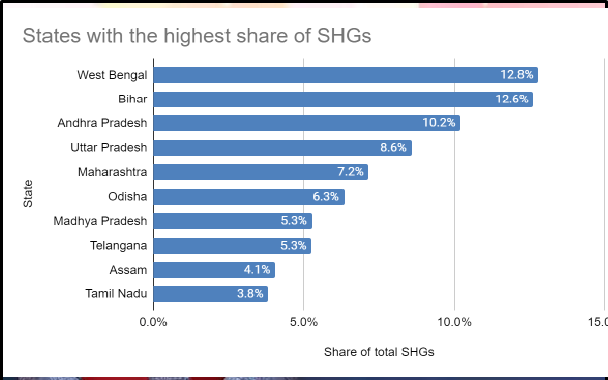INDIA’s SHGs EMERGING WORLD’s BIGGEST MICROFIN PROJECT
Relevance: GS 1 – Role of women and women’s organization
Why in the News?
- International Women’s Day (March 8) marks a celebration of the remarkable success story of women leaders within India’s influential Self-Help Groups (SHGs).
- Their journey epitomizes hope and triumph, showcasing the power of determination and resilience.
- Through their efforts, they have demonstrated the transformative potential of grassroots movements led by women.
Formation and Purpose of SHGs
- SHGs typically consist of 10-12 women sharing similar socio-economic backgrounds.
- These groups unite to pool their financial resources for joint economic endeavors.
- Another purpose is to provide loans to members at reasonable interest rates to kickstart small businesses.
Impact and Empowerment
- The success of SHGs represents a genuine tale of hope and triumph, showcasing the unstoppable power of women.
- Their influence is pivotal in propelling development initiatives nationwide.
- SHGs are evolving into modern cooperatives, managing diverse tasks like water supply, waste management, community kitchens, and slum development.
Webinar Highlights
- Sunita Narain, Director General of the Centre for Science and Environment (CSE), emphasized the significance of SHGs at a webinar commemorating International Women’s Day.
- The webinar was organized by CSE in collaboration with Down To Earth magazine, featuring a cover story on SHGs.
- Distinguished panelists included notable women leaders and entrepreneurs from various SHGs across India:
- Meenu Singh, Director of AIIMS, Rishikesh.
- Heenaben Dave, Vice President of SEWA (Self-Employed Women’s Association),
- Meena Rahangdale, President of Yogyata Swa Sahayata Samuh, Balaghat (Madhya Pradesh).
- Mini Varghese, Mentor Resource Person at Kudumbashree, Kerala.
- Padma Tashi, Production Manager at Looms of Ladakh Women’s Cooperative, Leh.
- Sabita Behera, Jal Saathi, Puri (Odisha).
SHG Impact and Membership Statistics
- Data from the Deendayal Antyodaya Yojana-National Rural Livelihoods Mission in December 2023 reveals that India hosts nine million SHGs.
- These SHGs have nearly 100 million women as active members.
- With 65 million villages in India (according to the 2011 Census), there are approximately 14 SHGs per village, and every eighth Indian woman is an SHG member.
- Down To Earth estimates that each SHG facilitates the initiation of eight to 10 women-owned businesses, showcasing their significant role in fostering entrepreneurship.
Historical Context and Evolution of SHGs
- The origins of SHGs in India can be traced back to the 1970s, notably with the formation of SEWA (Self-Employed Women’s Association) in Gujarat.
- In 1992, SHGs were linked to banks through the SHG Bank Linkage Project (SHG-BLP), facilitating the provision of small loans for livelihood opportunities.
- Further momentum was gained in 1999 when the government integrated SHGs into the Swarn Jayanti Gram Swarojgar Yojana to promote self-employment in rural areas.
Government Support and Strengthening of SHGs
- The government’s deliberate efforts have strengthened SHGs, positioning them as key executors of India’s development agenda.
- In 2014, the creation of the Community Investment Fund provided SHGs with up to Rs 50,000 annually to design local livelihood programs.
- India’s SHGs collectively represent the world’s largest microfinance project, disbursing loans amounting to Rs 1.7 lakh crore by February 2024.
- The Economic Survey of India highlights the credit discipline and reliability of SHGs, with a bank repayment rate of over 96%.
Empowerment and Recognition
- In a predominantly male-dominated society, SHGs offer women a sense of empowerment and recognition.
- Membership in an SHG is considered a badge of honor, symbolizing a new identity of power for women.
- SHGs serve as exemplary models of how marginalized groups can effectively manage and sustain development initiatives previously deemed impossible.
Source: Hans India Editorial
Mains Question
In the context of India’s development agenda, discuss the role of Self-Help Groups (SHGs) in empowering women and fostering entrepreneurship. (250 words)




